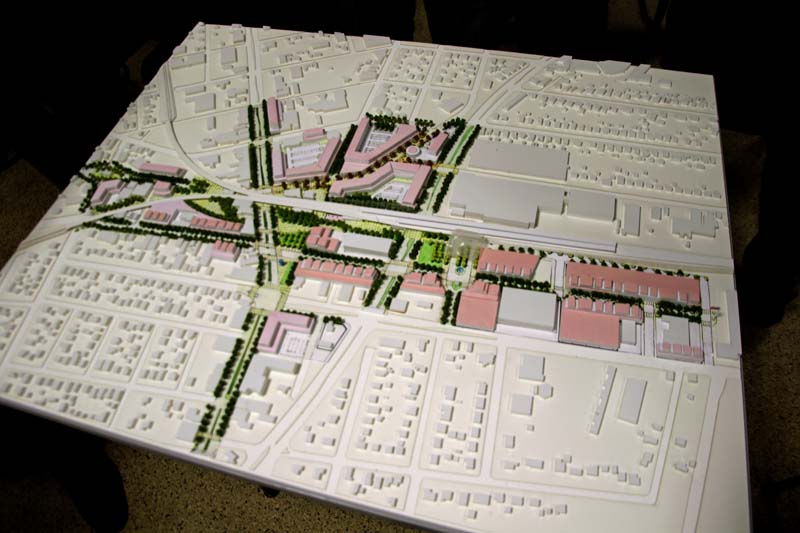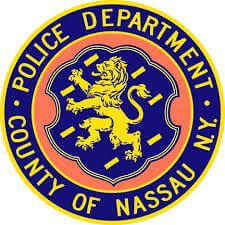
No matter how beautiful the renderings, and entrancing the visions, and clever the concepts, there were two worms in the apple.
Traffic and parking.
Those are the intractable dilemmas that make the transformation of downtown Hicksville challenging.
The Hicksville Downtown Revitalization Initiative’s (DRI) Local Planning Committee (LPC) held its third public meeting on Jan. 18. Dozens of attendees filled the Hicksville Community Center to hear the latest plans for how the hamlet will spend the $10 million grant it won last year as part of the state’s DRI program.
Many of the public comments dealt with traffic and parking issues, and it was evident that there were no easy answers.
Erik Wood and Cecil Bakalor of the NYC-based HKS architecture and design firm led the presentation. The firm received kudos from LPC members and the public alike for the renderings of possible projects in the downtown, focused on the train station area.
The multinational firm has designed three NFL stadiums and has a portfolio of high-priced projects.
But whether it’s huge developments or modest ones, the issues are the same, Wood told Anton Media Group: “To create a sense of place where people want to come and at the same time create value in the adjacent private sector.”
A tabletop low relief three-dimensional model was the focus of much attention and comment. Oyster Bay Supervisor Joseph Saladino, however, pointed out that it was a very preliminary rendering, and much could change.

Many of the LPC members had served on the Downtown Hicksville Revitalization Committee (DHRC). A number of the ideas from that committee’s final plan have been incorporated into the visions that HKS presented.
The project has a number of moving parts, and must mesh aims and aspirations that, it was obvious from public comment at the meeting, could conflict with each other.
The Metropolitan Transportation Authority (MTA) is spending $121 million to refurbish the train station, the busiest in the LIRR system outside New York City. The MTA is also planning to erect a parking garage to help address the parking shortage. The Town of Oyster Bay will need to change its zoning to comply with the vision of transforming its downtown. And Nassau County is reportedly undertaking a traffic study encompassing the area bordered by the DRI and even beyond.
Seen from the air, much of downtown Hicksville is covered by surface parking lots, mainly used by commuters. They are full during weekdays and empty in the evenings. Consolidating these lots into what the DHRC’s final report called “structured parking would free up land for development that can enhance, rather than detract from the surrounding community.” It noted that many downtown businesses don’t have enough parking during business hours, and introduced ideas of how shoppers, commuters and patrons of restaurants/bars in the evenings could share parking.
LPC member Phil Heckler said, “One of the things we talked about was recovering some of the land that is now street-level parking. It destroys the appearance and aesthetics of the downtown, and undermines the tax base. To reclaim that land, we always thought we needed some mixed use development with up to 500 units of co-ops and apartments and such.”
Private-Public

To paraphrase the quote made famous in Field of Dreams, “Talk about it, and they will come.”
James McCaffrey, deputy commissioner of economic development for Oyster Bay, said that the town reached out to property or business owners interested in locating in the DRI.
“There is a limited amount of funding, so as a committee, one of your jobs is to select the best projects that are economically viable and can happen in the next 18-24 months,” he stated, adding that the projects would also need to benefit the larger community.
Commented Wood, “The DRI program is very specific in that they would like to have ‘shovel-ready’ projects to invest in. Things that are ready to get started in the next 18 to 24 months, Some of the things we’ve talked about are very important to move Hicksville into the place it wants to be. So the LPC will need to instruct us on how to sort these things.”
“The numbers are daunting,” said Dave Kapell, co-chair of the LPC. “Ten million is a lot of money, but it doesn’t go very far on a project of this scale. I know from my experience that it will take a significant amount of time. The challenge here is to identify those activities that will spark everything else to happen.”
Wood agreed, saying, “This is a large vision that takes a significant investment and a longer period of time than what the DRI parameters have described.”
Words of hope came from co-chair Kapell, the former mayor of Greenport. One of his goals in that North Fork community was to build a public park along the harbor.
“We had no idea how to go about it and it took 13 years to do it,” he confessed.
Eventually, Greenport tapped 28 different funding sources to build Mitchell Park and Marina.
“It totally transformed the village,” said Kapell. “And before we even put a shovel in the ground, just talking about it and planning it, it induced private investment. Hotels and restaurants opened up along side of it.”
Kapell went on to say this same synergy could do the same thing for Hicksville.
These are the eight private projects that McCaffrey asked the LPC to assess:
- A boutique hotel on West Cherry Street, between Broadway and Jerusalem Avenue. It would be about 15,000 square feet and have an estimated cost of $15 million.
- A mixed-use development under the name 99 Hicksville Station Plaza. Proposal for 200 apartments above ground-level retail. Would be erected on Newbridge Road and has an estimated price tag of $20 million. The principals asked for $1.5 million of DRI funding to begin the building task.
- Oyster Bay Brewery: Would move from its present location in the hamlet of Oyster Bay. Owners propose to spend $1 million, but as of yet do not have access to a property.
- Trinity Lutheran Church and School. Would expand day care at its current location on West Nicholai Street.
- Mass Transit Training Facility: Proposed by Nassau County BOCES to train people for positions in mass transportation. Proposed in the West Barclay Street area.
- Oxygen Therapy Center: A proposed facility of 10,000 square feet dependent on property acquisition. Principals propose to spend $800,00 and are requesting $400,000 from DRI grant.
- Residential Expansion: Proposal to expand a current 88-unit residential buildings on Broadway. Predicated on buying property on Williams Street. Developers plan to spend $14,7 million.
- Digital Ballpark: A non-profit is looking to for 10,000-square-foot site to create a space that would have tech-based start-ups and support for aspiring entrepreneurs. All of the $5000,000 cost would come from the DRI funds.

Downtown Focus
For both Wood and Bakalor, “decongesting the area” encompassed by the DRI, especially around the train station, was one of the chief aims of their planning focus.
“A lot of improvement could be done here,” said Bakalor as a slide showing a photo near the railroad station was put up. “One of the things we feel is very important is to rationalize the access to the station.”
The plan calls for buildings that combine retail, commercial and housing, with integrated parking. Walkable areas will figure prominently among the million square feet of development. A series of plazas will be crowned by the expansion of John F. Kennedy Memorial Park from its current .75 acres to 4 acres. These will create the possibilities for festivals and farmers’ markets and other public gatherings.
“What you need to revive downtown Hicksville is coverage, a lot of development,” Bakalor observed.
LPC Co-Chair Gregory Carman Jr. said, “The concentration or focus has to be dominated by the train area on the station entry drive and new station plaza. Discussions have to happen between the town and the state and the MTA to make this go. So hopefully, the state has a lot of money to offer us (laughter) to make this become a reality.”
Bakalor put up a photo taken at the Hicksville train station and commented, “We’ve labeled this slide, ‘Conflict.’ I think that understates it. You have parking. You have people being dropped off. You have people walking to their cars. You have people waiting for people to get off the train. We feel this can be improved tremendously.”
He added, “One of the things that’s important here is to capture the million-plus people annually who get off the train, get in their cars and leave Hicksville. What we like about the Barclay proposal is that when they get off the train they have choices of restaurants and bars, of meeting people after work.”
The HKS plan envisioned the West Barclay Street area as a destination, with active sidewalks, shops and restaurants and plenty of pedestrians.
“It would be improved by putting trees, by putting landscaping and by putting lighting,” Bakalor said.
The widening of Broadway (Route 107) and Newbridge Road (Route 106) by the state in the 1960s essentially killed the walkable, downtown character of the hamlet, people noted.
The DRI vision called for these roads to become more pedestrian friendly.
Of Broadway, Bakalor said, “The big issue is to make it pedestrian friendly. That’s number one. We heard this over and over again. People have to feel comfortable crossing he street. This means crosswalks, pedestrian lights, seating, signage. All the things that make a street feel more like a place than a truck route through the center of [town].”
The plan envisions matching what Bakalor calls the existing, historical stores on the east side of the route with four-story buildings on the west side. These new buildings would have retail on the first floor, commercial or start-up firms on the second floor, and two floors of residential housing.
“You now have a street that starts to have scale to it,” Bakalor said of the proposal. “It starts to feel more like the old (before road widening) Broadway. You’re never going to get the “old” Broadway, but defining both sides of the street you start to get that.”
Bakalor showed slides of other municipalities that in his view proved that successful “main streets” were built up on both sides.
“And this is the kind of thing that we heard [in public comment] right from the start,” Bakalor observed. “That there were certain kinds of streets that people preferred and liked the character of (showing a slide of Main Street in Huntington).”
Streets & Parks
One of the key portions of the HKS plan is a series of public spaces that will supplant current drop-off points, as well as the forementioned expansion of JFK Park. The slides tabbed them as Station Plaza and Festival Plaza.
Wood said an appropriate next step would be “the extension of the public realm from the Station Plaza eastbound toward JFK Park…something that can get started in the next 12 to 18 months.”
The plan calls for changing the perception of JFK Park “from being a median to being an occupiable and effective gathering place for community events many people have mentioned that they would like to see happen here” according to Wood.
John Sarcone, an LPC member, thought the reimagined JFK Plaza would help define the downtown.
“As a Hicksville resident, one of the first questions you ask is ‘Where do you believe the downtown is?’ And we have different opinions. So, improving JFK Park—which is hard to get to and something that is not utilized—has tremendous potential.”
Town of Oyster bay Councilman and LPC member Tony Macagnone liked the idea of the nucleus of public spaces anchored by JFK Plaza.
“Let’s get started and let’s give residents something they could have and enjoy,” he stated.
“We believe this could have a dramatic effect,” Bakalor said of the proposed park expansion from .75 to 4 acres. “From hearing from the public at hearings they feel it’s not really a park…you can’t get to it. Look at all the [streets] you have to cross.”
With modifications to existing public areas, Bakalor went on, JFK Park can be transformed “from being a leftover traffic island to a usable park.”
Echoing Wood, Bakalor felt that it would appeal to the [LPC] as to where to make the first move, and start spending the grant money.
“It would be a place to do events such as farmers’ markets, and as housing starts to be built, it will be a place that people can use as an amenity,” Bakalor said.
Another area of attraction was Nelson Avenue, which starts at Broadway and makes its way south, paralleling Newbridge Road until it ends at Cherry Street. Bakalor loved the bend in the road, saying—as he showed slides of similar streets—that it had the potential for exciting visual possibilities.
“Downtown has problems—lots of empty sites, lots of at-grade parking. But one thing Hicksville has are great street blocks [with] incredible bends and odd-shaped blocks,” Bakalor said. “For us, his is an opportunity to do something really special [by reconfiguring Nelson] and making the crossing of Newbridge and Broadway more prominent. It’s an opportunity for [the block] to become the Hicksville destination.”
HKS also saw potential in West Barclay Street.
Wood called this “one of the big developments. The south side is owned mainly by the town. On the north [side of the street] you have large parcels that are owned by a handful of people. The ability to bring people to the table and collaboratively work toward bringing the character of Barclay into the transformed vision is much more possible on this stretch of Barclay.”
Modest investments such as putting streetscapes on this part of the road is not a big deal, Wood said, but full transformation and potential can only come with private sector investment,
The private sector will also be more engaged if thew town comes through with favorable zoning changes and density controls.
“The level of predictability of what the shape of those buildings and the character of the street [will be] will only encourage such private investment,” Wood pronounced. “[A transformed] Barclay Street can redefine how downtown Hicksville can be thought about.”
LPC member and Nassau County Legislator Rose Marie Walker was impressed by the variety of projects interested in the DRI.
“Hopefully, it will add more jobs and opportunities for young people right here in Hicksville,” she said. “After many years of struggling and getting no place…I think tonight we see something real start to happen.”
Lionel Chitty, former president of the Chamber of Commerce and chair of the Downtown Revitalization Committee that had been studying the problems, wondered if the time frame within which the DRI operates would preclude potential businesses from applying for a share of the grant money. He was told that there would be opportunities.

LPC Members Weigh In
Ryan Coyne, one of the committee’s youngest members, was concerned that “Long Island is in danger of losing a lot of its young people. Stats are coming out that people are fleeing because of the rising cost of housing.”
That is why he was so supportive of the DRI.
“It has tremendous value, to [make] the community stronger for decades to come…and lay the groundwork for a prosperous and successful Hicksville for the next 40 years. I’m really excited about that.”
Coyne was also excited about an item on the potential list of projects—the creation of a digital ballpark. He is associated with LaunchPad in nearby Westbury, billed as “a business incubator, startup accelerator, and co-working community.”
Coyne praised the potential facility as having “a ripple effect on the surrounding community. The private development of the digital ballpark, combined with better walkability and more housing opportunities will have a tremendous impact on the community.”
Linda Armyn said it was important to pay attention to Nelson Avenue because it was to be the center of the desirable mixed use.
She added, “I love [enhancing] JFK Park. I’ve talked to people around here and it needs to improve.”
Tony Widzinski praised the work of HKS, noting, “When we first started the puzzle there just a bunch of pieces. And what you have presented tonight [gave us] an idea of what downtown Hicksville is going to be. We have different ideas. Everybody was thinking downtown was Broadway. It’s not. It’s Nelson Avenue.”

Public Comments
John Budnick of Massapequa said he remained “interested conceptually in the Hicksville area,” where he was a former community activist. He spent years in the District Attorney’s office, dealing with crimes in the area in focus. He urged that the LPC try to get some kind of police presence in the vicinity of the train station. He also felt a hotel should be a high priority there.
Nick Sarandes of Hicksville immediately brought up traffic concerns, ticking off a list of new and future non-DRI affiliated developments he claimed would bring “a massive amount of cars into Hicksville.”
“More cars,” he warned, “will undermine these beautiful ideas and conceptions.”
Eileen Supran of Plainview put the parking problems front and center, and asked Wood if the shortage of parking was being studied or addressed.
Yes, was the answer, and later, McCaffrey stepped up to say the MTA would be building a garage on top of an existing parking lot that would add a net 900 spaces.
Supran spoke of the housing developments in Plainview, as well as Hicksville and surrounding areas. A lot of millennial with cars would be flooding the area, she noted. Many would be frequenting the Hicksville train station.
“You want young people to stay here,” she pointed out. “A lot of them have to commute to the city to make enough money to sustain a life here…and the LIRR parking situation is getting worse.”
Andree Smith complained that “Hicksville has become a giant eyesore (to applause).”
She suggested the old Cerro Wire site as a place where a parking lot could be put up.
Cheryl Brown detailed a trip to the FedEx office at 25 Newbridge and said, “There is no parking on that whole block. You’re going to put up a park there? Where are people going to park if you put up a park there?”
Her parting suggestion was for people to avoid that FedEx office.
Rich Pfeifer said he’s been a resident since 1953 “and I’m tired of people dumping on Hicksville,” he said bluntly, calling for a moratorium on building parking spaces.
“I know that people from other towns want to come in and commute to the city,” he said. “This is our home. They’re coming to our home to travel out of the area. I might have well open up my garage and have someone park in there (laughter). And now you’re talking about making nice pedestrian crosswalks. That’s going to hold traffic up. It will be backed up to the Northern State.”
Wood admitted he had no answers when Pfeifer asked him where the construction equipment would be stored when all the potential construction began.
“I like the project,” Pfeifer told Anton Media Group apropos the presentation. “But the traffic…”
Wood and More
“The program is focused on what intervention could take place in the near term that would enable Hicksville to reach toward its vision,” Wood said after the last public speaker. “None of the things we have shown today have gone down to that level of detail to resolve the issues that some of the people have mentioned. What we’ve been able to do is think through a series of steps which we believe as private developers come forward on the property they own, that the parking can work in tandem with that development. The parking lots that the town currently owns can be increased.
Wood believed that with a shared parking strategy involving commuter, retail and residential uses, “there will be ample parking supplied.”
As for traffic, he said it would have to wait on the ongoing traffic study.
As for the MTA, Wood said, “[It] is interested in increasing the parking spots for the commuters, so being able to employ a shared parking strategy here is going to be absolutely critical in order for this kind of development to take place. And we believe the MTA, from our conversations, is very willing to take that approach, in part because they see the ability to generate [economic] activity in and around their train stations to be of great benefit, not only for their ridership, but for the towns they are within.”
In an interview with Anton Media Group, Wood said, “The DRI study is focused on revitalization efforts that could be funded by the DRI program. That’s the lens within which this [planning] is being done.”
Eric Alexander of Vision Long Island has been involved with helping to plan a number of downtowns and was part of the Hicksville Downtown Revitalization Committee.
“You talk to Hicksville residents and business owners and you see consensus for three- or four-story buildings, public spaces and walkability. Everybody wanted that from day one,” he told Anton Media Group.
Alexander said he had been a two meetings in Hicksville attended by hundreds of people. A vast majority favored changing the zoning in the downtown area to match the vision of a revitalized Huntington.
“Some people are always going to be unhappy, but when you get up to 70 percent support for what you’re trying to do, and hear it again and again, that’s valid,” he observed. “That [downtown] vision has been validated by the community.”
Of the DRI planning process, which is funded separately, Alexander noted, “The state is investing serious amounts of resources to planning, [spending] $300,00 to make sure that the $10 million [grant will result in] projects that [comply] with public consensus and market realities.”































